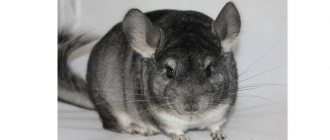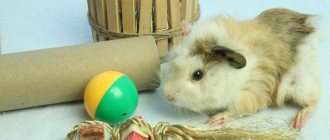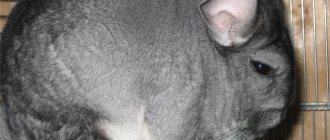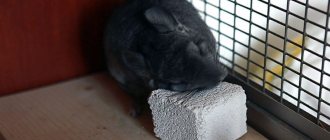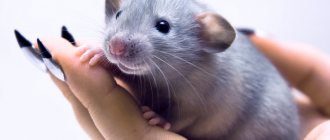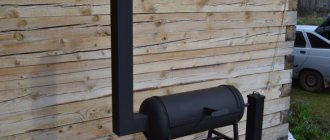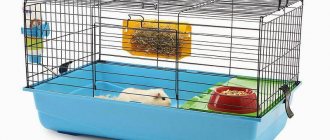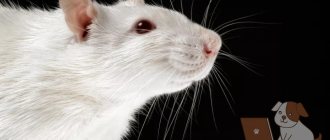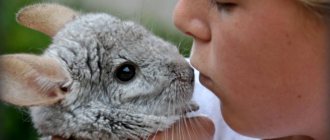Chinchillas are active, positive and very funny animals. Many breeders, in order to diversify their pet’s days, buy and install special toys in their cages. In addition to toys, furry pets require accessories such as a carrier and a fur brush. Some owners also buy harnesses and leashes, but there are many dangers associated with their use.
Types of toys for chinchillas
Toys for furry rodents are made from different materials, but they all have one common requirement - safety. Therefore, you should not buy and use toys from:
- Plastics,
- Rubbers,
- Plexiglas,
- Cardboard, foam or paper,
- Any material with a high content of gels, paints or varnishes,
- Any material containing cement or lime.
Most often, toys for animals are made from ceramics, wood, stone, metal and plant fibers.
Wooden toys must not contain any traces of paint and be made from approved types of wood:
- Beech,
- And you,
- Poplars,
- Apple trees,
- Cherries,
- Birches.
Wooden toys can be either static - attached to the floor or walls, or free-lying. All kinds of swings and ladders, houses, shelves, labyrinths and ladders are most often made from wood.
When choosing a ceramic toy, you should carefully inspect it for the absence of sharp corners or protrusions. You can use flower pots, drainage pipes of suitable diameter and other pottery items.
Stone toys are designed to grind down constantly growing teeth, which means they should not contain dangerous inclusions. Most often, stone toys are stones for grinding teeth. Sometimes they are shaped like a castle, a fruit or a vegetable.
All kinds of ropes, hammocks and ladders, ropes, bedding, baskets and bowls are made from plant fibers. The main condition is that the fabric must not be bleached or dyed.
Metal toys are represented by various running wheels.
Necessary materials
The simplest variety to make yourself is a figure eight shaped harness. In order to make it, you only need one rope. It should be long enough, so it should be used for the area around the neck and body. Therefore, its length should be at least 20cm. Any material will do
However, it is important to avoid rough abrasive ropes, which can irritate the rat's skin.
- A collar that fits the rat's neck.
- One that will hug her chest just behind her front paws.
- A long collar that will be used as a connecting element.
To create a vest harness you will need high-quality elastic fabric and a metal ring. You can use special fabric for animals, but regular fleece or cotton fabric will do just fine.
DIY pet toy
Toys can be not only purchased. Chinchillas are quite smart animals and adapt a variety of objects for their games. Even a nut shell can become a furry pet's favorite toy. Some breeders prefer to make toys for chinchillas with their own hands. For the most popular option you will need:
- Metal chain from a hardware store,
- Several metal key rings,
- Branches of any permitted tree,
- Drill,
- Saw.
The twigs must be washed well and dried, preferably in the oven. The branches are sawn into bars and rounds. A hole is drilled in each of them, with a diameter equal to the diameter of the chain. A chain is threaded through all the branches, and key rings are attached to its ends. They are very convenient for hanging a ready-made toy on the walls of the cage. The number of branches and the length of the chain depends only on the wishes of the breeder and the size of the cage!
Stuffed Toys
But the use of soft toys is a very controversial issue. Some breeders claim that their pets play with plush toys and even sleep cuddled with them. However, most have a negative experience: the toy quickly breaks into pieces, the filler and other parts end up in the pet’s stomach and cause poisoning of varying severity, intestinal obstruction and even death. If you wish, you can try giving a soft toy to your pet and see his reaction. It is likely that the animal will make friends with the toy. However, this does not mean that after some time the chinchilla’s plush friend will not be torn to pieces.
What are there
The main models are:
- harness;
- harness-vest;
- leash with collar;
- walking ball.
A regular harness is shaped like a figure eight, fastened in the middle with a leather pad to which the leash is attached. One figure eight ring is threaded under the pet’s tummy, and the other is fixed in front of the front paws, covering the neck.
If such a harness is larger or smaller than the pet, then it will be uncomfortable for him to breathe, or the hamster will fall out of it, so the harness mount is movable so that it can be adjusted to the size of the pet.
The size of the harness is checked with your little finger: if you can put a finger between the fastening and the back, then this is the optimal size for the hamster.
The harness-vest resembles a vest with a leash attached at the top. The model is comfortable, does not interfere with movement, and the animal will not fall out.
A leash with a collar is worn in the same way as for other animals. This leash is only suitable for large breed hamsters. This is the least convenient model. Safety measures are especially important in it: prevent it from falling out of the collar, do not make sudden jerks, etc.
A walking ball is a ball made of polymers or plastic with breathing holes and a side lid. Having placed the hamster in the ball, you just need to close the lid and let it onto the floor or onto the platform.
This way the animal will be safe from contact with cats or dogs, and nothing will interfere with its movements. A ball is a better option for training muscles and providing physical activity than a wheel in a cage.
Chinchilla carrier
When choosing a carrier, you should focus on what it will be used for. If for a short trip - to the doctor or to the country, then it is better to choose a small box that can be easily placed in a bag and insulated if necessary. It is better not to buy a carrier that is too large - the animal can easily be injured. However, the box should not be too cramped - cramped space will lead to stuffiness. There is no need to try to find one carrier for two or more animals: transportation is always carried out in individual boxes.
The most convenient and practical carrying option is a plastic container.
One of the most popular manufacturers of pet products, Ferplast, has in its product line a carrier for chinchillas with dimensions of 36 by 26 by 23 cm. This type of transport box, at its low cost, has enough holes for ventilation, is reliable and durable. An additional plus is that the bottom of the side is solid, which means the filler will not be scattered throughout the bag.
During the cold season, it is recommended to place the carrier in a bag. You can use any sports bag of a suitable size, or a special one for transporting animals.
Before placing the animal in the carrier, the bottom must be covered with bedding. Typically, sand for chinchilla bathing, sawdust or wood granules serve as bedding. Sand is very convenient, but it is not recommended to use it if your pet is going to a show. Grains of sand that get on the fur will distort the natural color of the pet. During the winter months, the use of sand is also controversial during long-term transportation: sand does not retain heat well.
In winter, it is recommended to insulate the carrier with hay, as well as put some of your favorite treat - this will help cope with stress.
Accessories for walking
There are many accessories that are used when walking. In specialized stores you can purchase:
- leash with collar;
- harness (made of loops or in the form of a vest);
- walking ball.
In a walking ball, the hamster will be able to safely move around the entire territory.
For street walks, you will have to choose between a harness or a regular leash with a collar.
Vests, which are available in different colors, a large number of models from various materials, are especially popular. It protects the animal from dirt and precipitation, securely fixing its body.
Clothing, leashes and harnesses for chinchillas
The accessories for chinchillas presented in stores today are so diverse that they confuse breeders. The most controversial product is the leash with harness. It is strictly forbidden to walk chinchillas on the street. And there are several reasons for this:
- Chinchilla fur is easily damaged by any harness or collar,
- Chinchillas don't walk - they move by jumping. A collar can break your spine, a harness can break your ribs,
- There are quite a lot of dangerous bacteria, microbes, fungi,
- A sudden change of environment, new smells and sounds, bright light - all this will lead to very strong stress and can provoke a heart attack.
- A chinchilla is usually walked at home, but for home walks a harness and leash are not needed.
- In the same way, leashes and harnesses are not needed for exhibitions - the animal is placed from the carrier into the exhibition box.
Products for chinchillas include a variety of clothes: vests, jackets, shorts, overalls and dresses. There is no need to talk about the actual use of such accessories: you cannot leave an animal in clothes in a cage - in a few minutes the pet will chew everything it can reach and also get poisoned by the dyed fabric. At exhibitions, animals also do not need additional decorations. The downside is that the chinchilla is a freedom-loving animal, and it can be very difficult to persuade the animal to wear clothing that restricts movement.
It is also worth remembering that the animal’s fur is quite dense and warm, which means you can get heat stroke from wearing clothes, especially in the summer months.
Benefits of walking
Veterinarians are divided on the issue of walking so many small animals. Some people think this is a bad idea, citing the high likelihood of the pig suffering psychological and psychological damage. Others counter with the factor of the benefits of fresh air for domestic rodents. Recently, popularity has shifted to supporters of active walks with guinea pigs - but with reservations.
Walking your pet in the average yard may not be a good idea. There is so much noise and traffic around that the pig can get psychological trauma. There is an even greater danger from other animals - street cats and dogs, who see such easy prey. They can do something irreparable. Therefore, you can only walk in quiet and peaceful places where danger is minimized.
At the same time, walks in the fresh air, the opportunity to run on the grass and chew on twigs to the fullest are very useful for guinea pigs. They may be domestic animals, but they are active and inquisitive animals. Their mood noticeably improves, which gives the owner positive emotions.
The benefits of walking a guinea pig include the following:
- These furry creatures are prone to obesity, despite their miniature size. Walking does not threaten them with this disease.
- Pigs are social animals; being confined to their own home can, oddly enough, depress them. Introducing such variety will help avoid stress in your mumps and its unpleasant consequences.
- A harness for a guinea pig is necessary - a guarantee that the animal will not disappear without a trace under the nearest bush.
Fur care
But what is really needed is a good brush to care for the animal’s thick fur. They get used to using a comb gradually. Usually chinchillas like this procedure and do not express dissatisfaction. Regular brushing will help avoid many problems with skin and fur: dermatitis, fungal diseases, infection with skin parasites. Also, using a comb before the exhibition, you can give your pet a more neat appearance.
However, finding a special comb for a chinchilla in Russia is not so easy: the product is quite rare and expensive.
It differs from ordinary brushes for animals by thinner, sharper and more frequent teeth, which can be compared to needles from a sewing machine. This brush combs out the animal’s thick fur well. You have a better chance of purchasing a special comb if you go to a large nursery. Typically, large breeders bring specialized products from European farms or work directly with manufacturers of products specifically for chinchillas. If this is not possible or the price of the product is too high, you can choose a brush for a cat or dog with the longest and most frequent teeth.
Guinea pigs' reaction to walking on a leash
Animals are divided into 2 types - very shy and simply shy. For the first, a walk in open space ends with enormous stress. The pig may even get sick from fright. Rodents of the second type experience moderate stress, which displaces curiosity and the desire to nibble on fresh greens.
In order for your pet to adapt to open space and enjoy walks, you need to follow 3 rules:
- Start getting used to the leash gradually . First, just put it on your pig. Let her stay in it for 3-5 minutes. Take it off. Dress her a second time and let her walk around a small space. Take her outside only when she gets used to the open space.
- Do not drag the pig along with you , but follow it - this is its walk, not the owner's.
- As soon as other animals appear , pick them up and hide them under a special piece of fabric. This way your pet will feel safe and will quickly recover from stress.
Nursery of decorative rats, Moscow
You can find rat harnesses . Is it necessary?
I can immediately say that buying a rat harness is money thrown away. The first and main reason for this is the unique structure of the rat’s skeleton, thanks to which it can twist out of any position. Plus, a rat can simply chew it through.
In addition, it is almost impossible to put a harness on a rat correctly. If you tighten it a little more, the rat may simply refuse to walk and fall over on its side. And if you weaken it a little, the rat will run away before you even have time to blink an eye. There are rats that move perfectly on a harness . But usually these are calm individuals who, even without it, will not leave their owner even a single step. A harness can be useful in two cases:
- It can be put on a rat that sits on your shoulder while walking. The harness will not interfere with her in such a situation, but will help catch the rat in case of a fall.
- For beauty. A rat on a harness will look very impressive in photographs, at performances and competitions... The rat will last three minutes, and you will have time to appear in all your glory.
Whether to buy a harness or not is your choice. But you shouldn’t expect real benefits from it.
Curious pets, decorative rats love to walk, exploring new territories with curiosity and examining everything around them. A rat harness will ensure a safe walk around the house, yard or along the street. What it should be like, how to make it with your own hands, this article tells.


